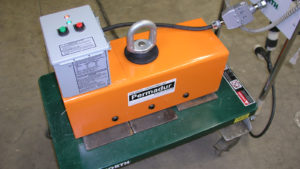Although all permanent lifting magnets are designed to do the same thing, there are differences between types of systems and magnetics. Each type of system excels in specific applications, meaning no two systems or magnets should be used interchangeably. It is necessary to take into consideration your needs and options before deciding. Below, we highlight the main differences between the three lifting magnet types.
PERMANENT LIFTING MAGNETS
These systems are solid and dependable. One of their unique qualities allows them to be operated without an electrical supply while lifting and handling. This lifting magnet does not lose power or drop loads when electricity/power fails. It is the safest and most reliable option. It is essential to recognize that permanent lifting magnets have a reduced magnetic field and corrode with time. Make sure to closely monitor the performance of these magnets because they can lose magnetic properties after many operations.
ELECTRIC LIFTING MAGNETS
These systems require a continuous current to safely complete work. As a result, systems can get hot as currents flow through windings. These types of magnets need much energy to perform optimally. Although losing power is detrimental to operations, the ability to alter power allows magnets to scale in power. These systems create deep magnetic fields that penetrate several plates in a stake. These systems are frequently referred to as plate lifting magnets.
ELECTRO-PERMANENT LIFTING MAGNETS
This system brings together the best of both above types. They operate during power failures and have direct power during activation. There tend to be air gaps between magnets and loads, and capacity decreases as gaps increase. You should not use these systems for lifting rough and uneven loads.
Regardless of the type of plate lifting magnet, it is essential to do your homework and get the safest type for your specific operations. Call today for more information about our permanent and plate lifting magnets.


